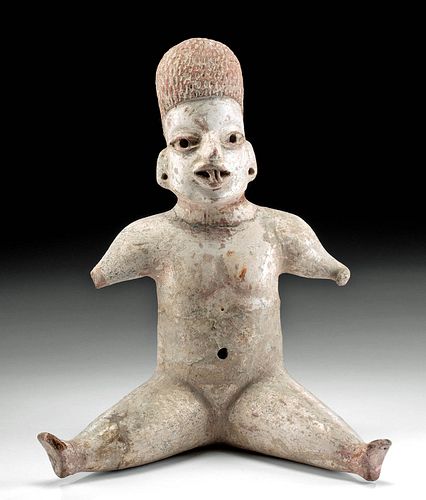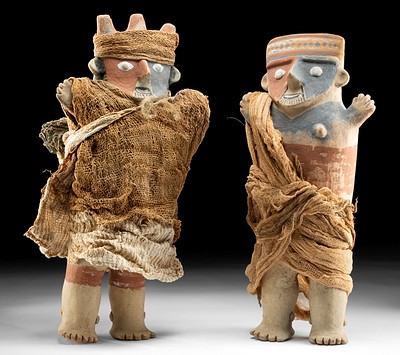Olmec Terracotta Seated Baby Figure - TL Tested
Lot 93d
About Seller
Artemis Gallery
686 S Taylor Ave, Ste 106
Louisville, CO 80027
United States
Selling antiquities, ancient and ethnographic art online since 1993, Artemis Gallery specializes in Classical Antiquities (Egyptian, Greek, Roman, Near Eastern), Asian, Pre-Columbian, African / Tribal / Oceanographic art. Our extensive inventory includes pottery, stone, metal, wood, glass and textil...Read more
Categories
Estimate:
$4,500 - $6,750
Absentee vs Live bid
Two ways to bid:
- Leave a max absentee bid and the platform will bid on your behalf up to your maximum bid during the live auction.
- Bid live during the auction and your bids will be submitted real-time to the auctioneer.
Bid Increments
| Price | Bid Increment |
|---|---|
| $0 | $25 |
| $300 | $50 |
| $1,000 | $100 |
| $2,000 | $250 |
| $5,000 | $500 |
| $10,000 | $1,000 |
| $20,000 | $2,500 |
| $50,000 | $5,000 |
| $100,000 | $10,000 |
| $200,000 | $20,000 |
About Auction
By Artemis Gallery
May 19, 2022
Set Reminder
2022-05-19 10:00:00
2022-05-19 10:00:00
America/New_York
Bidsquare
Bidsquare : Fine Antiquities | Ethnographica | Fine Art
https://www.bidsquare.com/auctions/artemis-gallery/fine-antiquities-ethnographica-fine-art-9350
Featuring a very special collection of Fine Art from the Hollywood Hills, including Picasso & Rookwood ceramics! Also included are many fine examples of classical antiquities, ancient, and ethnographic art from cultures encompassing the globe. Artemis Gallery info@artemisgallery.com
Featuring a very special collection of Fine Art from the Hollywood Hills, including Picasso & Rookwood ceramics! Also included are many fine examples of classical antiquities, ancient, and ethnographic art from cultures encompassing the globe. Artemis Gallery info@artemisgallery.com
- Lot Description
Pre-Columbian, Southern Mexico to Guatemala, Olmec, ca. 1200 to 600 BCE. A charming pottery figure of a baby depicted sitting with characteristically fleshy limbs extended - legs splayed apart and arms outstretched - each tapered to a petite hand or foot. The endearing child presents with a bit of extra body fat that we endearingly refer to as baby fat, which is interrupted by an openwork navel. His elongated head presents with an expressive visage comprised of puffy cheeks, slanted eyes with perforated pupils, a protruding nose, and an open mouth revealing two sharp teeth, crowned by a cap-like coiffure that is impressed with a rhythmic texture and adorned with red pigment. This oblong shape of the head has been attributed to deliberate skull shaping. The skin boasts remains of white pigment with some traces of red pigment here and there. A wonderful example with hallmark Olmec baby facial features as well as a playful attitude and infantile pose. Size: 10.3" W x 12.5" H (26.2 cm x 31.8 cm)
The Olmec are famous for their human depictions; as the first major civilization in this fertile area, their artwork inspired the civilizations that came after them to the point that we think some of them even revered Olmec artwork and kept it as heirlooms. Figures of this style are known as "baby face," with plump bodies and chubby, pouty facial features. Infants are a recurring theme from Olmec art, though who they actually represent is unknown. According to James Doyle, Assistant Curator, Department of the Arts of Africa, Oceania, and the Americas at the Metropolitan Museum of Art, "These could be portraits of elite babies, infantilized portraits of actual individuals, idealized portraits of deities or mythological characters, or some other type of ritual agent. They could be memorials to infants that left this world too early, or representative emblems of whole lineages."
This piece has been tested using thermoluminescence (TL) analysis and has been found to be ancient and of the period stated. A full printed and bound report is available to the buyer upon request.
Provenance: private Hidden Valley Lake, California, USA collection, purchased on June 12, 2020; ex-Artemis Gallery; ex-private Hillard collection, Boulder, Colorado, USA; ex-Tucson, Arizona, USA collection, acquired before 1980
All items legal to buy/sell under U.S. Statute covering cultural patrimony Code 2600, CHAPTER 14, and are guaranteed to be as described or your money back.
A Certificate of Authenticity will accompany all winning bids.
PLEASE NOTE: Due to recent increases of shipments being seized by Australian & German customs (even for items with pre-UNESCO provenance), we will no longer ship most antiquities and ancient Chinese art to Australia & Germany. For categories of items that are acceptable to ship to Australia or Germany, please contact us directly or work with your local customs brokerage firm.
Display stands not described as included/custom in the item description are for photography purposes only and will not be included with the item upon shipping.
#170463Repaired from multiple pieces with areas of restoration over the break lines, but some break lines visible. Loss of right hand. Restoration to top of head and proper right lower leg, ankle, and foot. Note the head, right foot, left leg, and left arm have been reattached. Expected surface wear with nicks, abrasions, and pigment loss as shown. Chipping to feet and hand. Annular perforations on verso beneath each arm. Otherwise, very nice with great remaining pigments and areas of mineral deposits. TL holes to torso, arms, and underside of legs.Condition
- Shipping Info
-
All shipping is handled in-house for your convenience. Your invoice from Artemis Gallery will include shipping calculation instructions. If in doubt, please inquire BEFORE bidding for estimated shipping costs for individual items.
-
- Buyer's Premium



 EUR
EUR CAD
CAD AUD
AUD GBP
GBP MXN
MXN HKD
HKD CNY
CNY MYR
MYR SEK
SEK SGD
SGD CHF
CHF THB
THB














